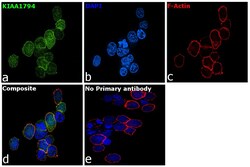Antibody data
- Antibody Data
- Antigen structure
- References [0]
- Comments [0]
- Validations
- Western blot [2]
- Immunocytochemistry [2]
- Immunohistochemistry [1]
- Chromatin Immunoprecipitation [1]
Submit
Validation data
Reference
Comment
Report error
- Product number
- PA5-59014 - Provider product page

- Provider
- Invitrogen Antibodies
- Product name
- FANCI Polyclonal Antibody
- Antibody type
- Polyclonal
- Antigen
- Recombinant full-length protein
- Description
- Immunogen sequence: YGKGVLSGEE CKKQLINTLC SGRWDQQYVI QLTSMFKDVP LTAEEVEFVV EKALSMFSKM NLQEIPPLVY QLLVLSSKGS RKSVLEGIIA FFSALDKQHN EEQSGDELLD VVTVPSGE Highest antigen sequence identity to the following orthologs: Mouse - 72%, Rat - 73%.
- Reactivity
- Human
- Host
- Rabbit
- Isotype
- IgG
- Vial size
- 100 µL
- Concentration
- 0.6 mg/mL
- Storage
- Store at 4°C short term. For long term storage, store at -20°C, avoiding freeze/thaw cycles.
No comments: Submit comment
Supportive validation
- Submitted by
- Invitrogen Antibodies (provider)
- Main image

- Experimental details
- Knockdown of KIAA1794 was achieved by transfecting A-431 cells with KIAA1794 specific siRNAs (Silencer® select Product # s226830, s226829). Western blot analysis (Fig. a) was performed using whole cell extracts from the KIAA1794 knockdown cells (lane 3), non-specific scrambled siRNA transfected cells (lane 2) and untransfected cells (lane 1). The blot was probed KIAA1794 Polyclonal Antibody (Product # PA5-59014, 1 µg/mL) and Goat anti-Rabbit IgG (H+L) Superclonal™ Secondary Antibody, HRP conjugate (Product # A27036, 0.25 ug/ml, 1:4000 dilution). Densitometric analysis of this western blot is shown in histogram (Fig. b). Decrease in signal upon siRNA mediated knock down confirms that antibody is specific to KIAA1794.
- Submitted by
- Invitrogen Antibodies (provider)
- Main image

- Experimental details
- Western blot was performed using Anti-KIAA1794 Polyclonal Antibody (Product # PA5-59014) and a 160kDa band corresponding to KIAA1794 was observed in Jurkat, MOLT-4, MCF7, A-431, HEK-293, HeLa, K-562, Daudi and U-87 MG. An uncharacterized band (*) corresponding to 50kDa was observed in all cell lines. Whole cell extracts (30 µg lysate) of Jurkat (Lane 1), MOLT-4 (Lane 2), MCF7 (Lane 3), A-431 (Lane 4), HEK-293 (Lane 5), HeLa (Lane 6), K-562 (Lane 7), Daudi (Lane 8) and U-87 MG (Lane 9) were electrophoresed using NuPAGE™ 4-12% Bis-Tris Protein Gel (Product # NP0322BOX). Resolved proteins were then transferred onto a nitrocellulose membrane (Product # IB23001) by iBlot® 2 Dry Blotting System (Product # IB21001). The blot was probed with the primary antibody (1 µg/mL) and detected by chemiluminescence with Goat Anti-Rabbit IgG Secondary Antibody, HRP conjugate (Product # A27036, 1:4000 dilution) using the iBright FL 1000 (Product # A32752). Chemiluminescent detection was performed using Novex® ECL Chemiluminescent Substrate Reagent Kit (Product # WP20005).
Supportive validation
- Submitted by
- Invitrogen Antibodies (provider)
- Main image

- Experimental details
- Immunofluorescent staining of KIAA1794 in human cell line A-431 shows positivity in nucleus & plasma membrane. Samples were probed using a KIAA1794 Polyclonal Antibody (Product # PA5-59014).
- Submitted by
- Invitrogen Antibodies (provider)
- Main image

- Experimental details
- Immunofluorescence analysis of KIAA1794 was performed using Jurkat cells. The cells were fixed with 4% paraformaldehyde for 10 minutes, permeabilized with 0.1% Triton™ X-100 for 15 minutes, and blocked with 2% BSA for 1 hour at room temperature. The cells were labeled with KIAA1794 Polyclonal Antibody (Product # PA5-59014) at 1:100 dilution in 0.1% BSA, incubated at 4 degree Celsius overnight and then labeled with Goat anti-Rabbit IgG (H+L) Superclonal™ Secondary Antibody, Alexa Fluor® 488 conjugate (Product # A27034) at a dilution of 1:2000 for 45 minutes at room temperature (Panel a: green). Nuclei (Panel b: blue) were stained with ProLong™ Diamond Antifade Mountant with DAPI (Product # P36962). F-actin (Panel c: red) was stained with Rhodamine Phalloidin (Product # R415, 1:300). Panel d represents the merged image showing predominant nuclear as well as cytosolic localization. Panel e represents cells with no primary antibody to assess background. The images were captured at 60X magnification.
Supportive validation
- Submitted by
- Invitrogen Antibodies (provider)
- Main image

- Experimental details
- Immunohistochemical staining of FANCI in human testis tissue shows strong nuclear positivity in cells in seminiferus ducts. Samples were probed using a FANCI Polyclonal Antibody (Product # PA5-59014).
Supportive validation
- Submitted by
- Invitrogen Antibodies (provider)
- Main image

- Experimental details
- Chromatin Immunoprecipitation (ChIP) assay of endogenous FANCI protein using Anti-FANCI Antibody: ChIP was performed using Anti-FANCI Rabbit Polyclonal Antibody (Product # PA5-59014, 5 µg) on sheared chromatin from Methane methyl sulphonate treated HCT 116 cells (1mM for 2 hours) using the MAGnify ChIP System kit (Product # 49-2024). Normal Rabbit IgG was used as a negative IP control. The purified DNA was analyzed by qPCR using primers binding to CDKN1A intron 1, 18s rDNA, promoter and transcriptional start site of GAPDH, and SAT2 satellite repeats. Data is presented as fold enrichment of the antibody signal versus the negative control IgG using the comparative CT method.
 Explore
Explore Validate
Validate Learn
Learn Western blot
Western blot